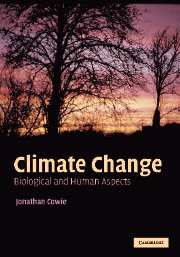Book contents
- Frontmatter
- Contents
- Introduction
- Acknowledgements
- 1 An introduction to climate change
- 2 Principal indicators of past climates
- 3 Past climate change
- 4 The Oligocene to the Quaternary: climate and biology
- 5 Present climate and biological change
- 6 Current warming and likely future impacts
- 7 The human ecology of climate change
- 8 Sustainability and policy
- Appendix 1 Glossary and abbreviations
- Appendix 2 Bio-geological chronology
- Appendix 3 Calculations of energy demand/supply and orders of magnitude
- Appendix 4 The IPCC 2007 report
- Index
- References
4 - The Oligocene to the Quaternary: climate and biology
Published online by Cambridge University Press: 17 December 2010
- Frontmatter
- Contents
- Introduction
- Acknowledgements
- 1 An introduction to climate change
- 2 Principal indicators of past climates
- 3 Past climate change
- 4 The Oligocene to the Quaternary: climate and biology
- 5 Present climate and biological change
- 6 Current warming and likely future impacts
- 7 The human ecology of climate change
- 8 Sustainability and policy
- Appendix 1 Glossary and abbreviations
- Appendix 2 Bio-geological chronology
- Appendix 3 Calculations of energy demand/supply and orders of magnitude
- Appendix 4 The IPCC 2007 report
- Index
- References
Summary
We are currently in the middle of an ice age! This ice age is known as the Quaternary ice age, and it began roughly about 2 million years ago (2 mya). (‘Roughly’ because how much ice do you need on the planet to say that it is an ice age?) We might not think we are in an ice age and this is because we are in a warm part, called an interglacial. As we shall see, there have been a number of glacials and interglacials in our Quaternary ice age. However, this ice age did not just start by itself but arose out of a number of factors that became relevant earlier, in the Oligocene (34–23 mya) and Miocene (23–5.3 mya) eras, well before the beginning of our ice age and its Pliocene and Pleistocene glaciations (Zachos et al., 2001). These glaciations actually had their beginnings some 5.3 mya. To understand how our Quaternary ice age came about we will need to briefly re-cap part of the previous chapter and note some other material to provide a more biological perspective while leaving out the extinction events.
The Oligocene (33.9–23.03 mya)
Between 35 and 15 mya the Earth's temperature was roughly 3–4 °C warmer than today and atmospheric carbon dioxide concentrations were twice as high. However, climate-forcing factors were coming into play that were to cool the planet.
- Type
- Chapter
- Information
- Climate ChangeBiological and Human Aspects, pp. 113 - 183Publisher: Cambridge University PressPrint publication year: 2007



